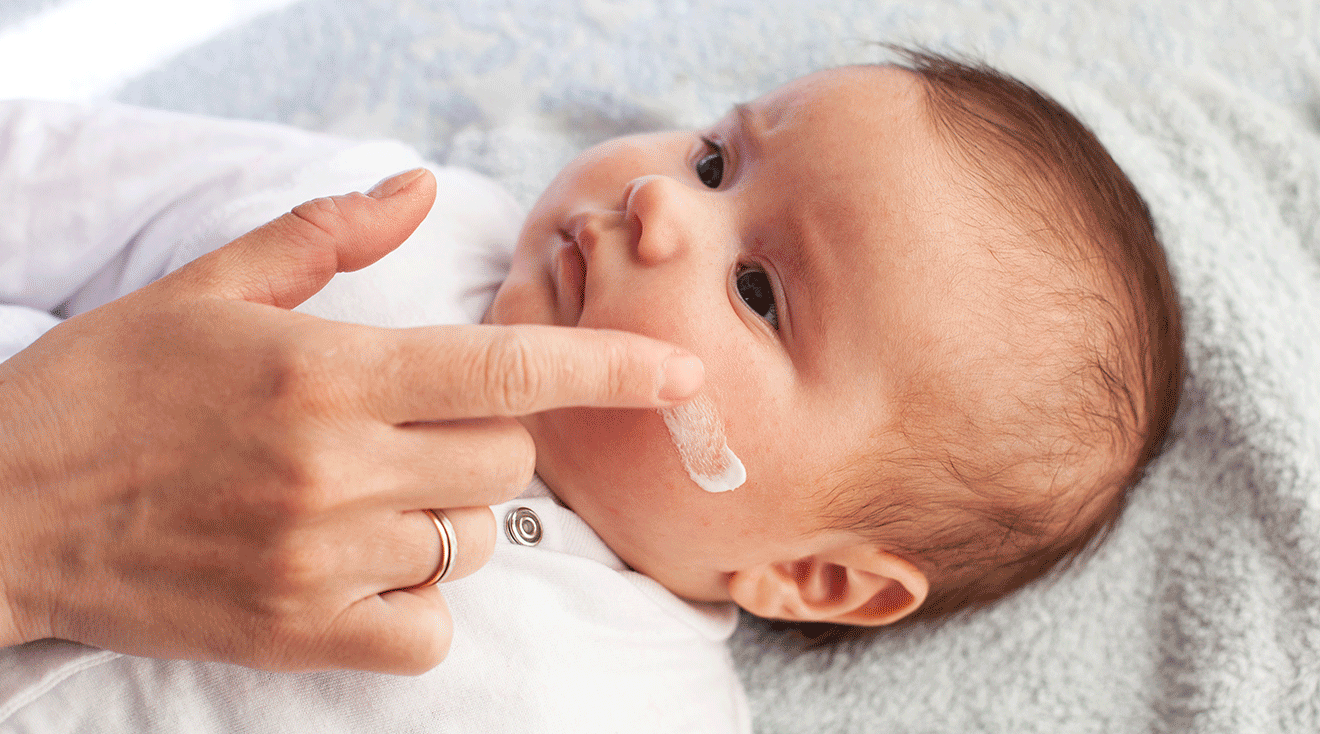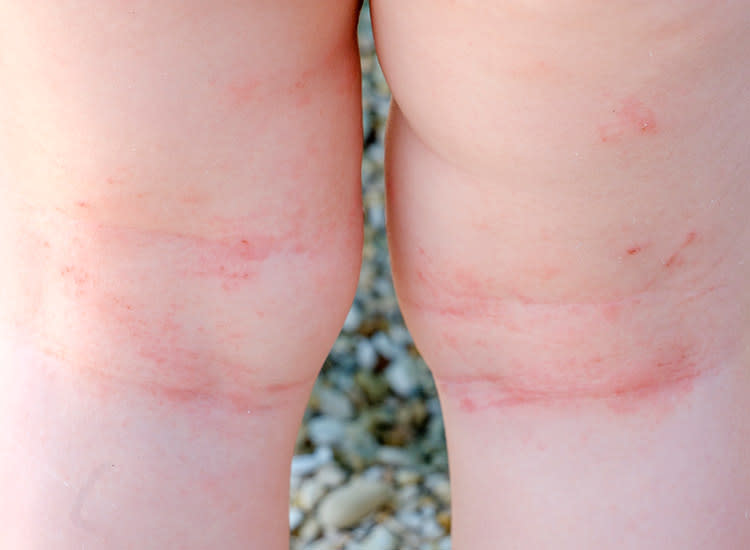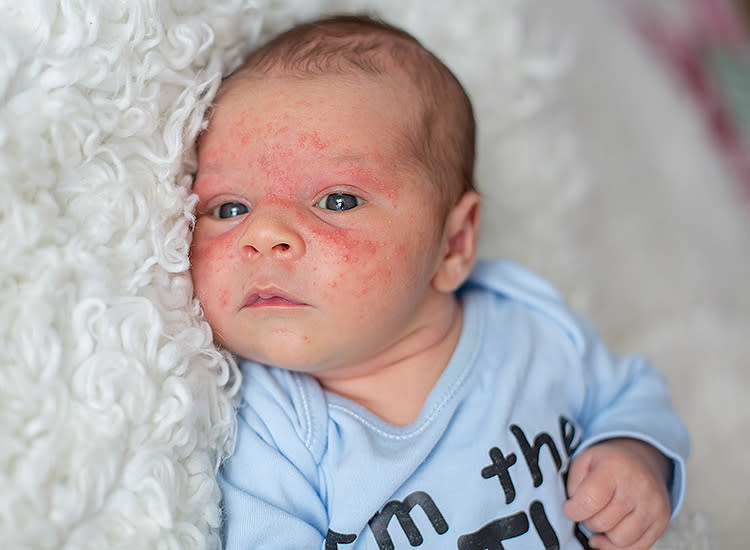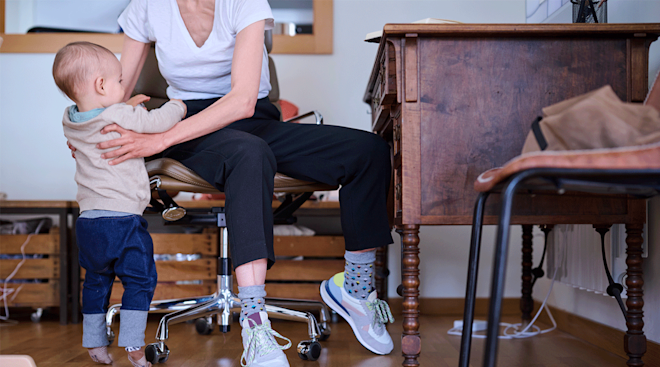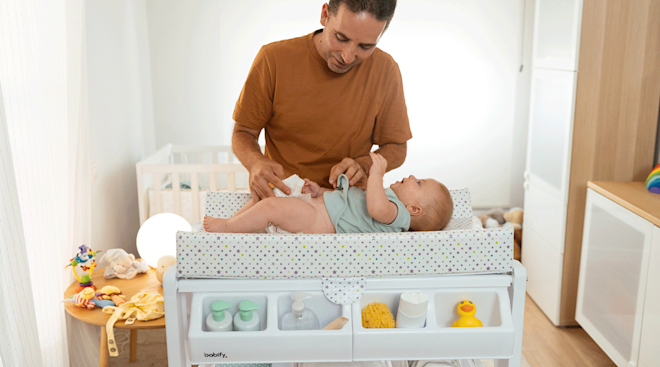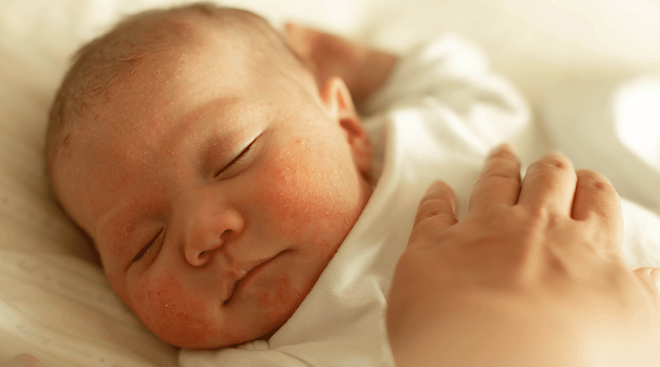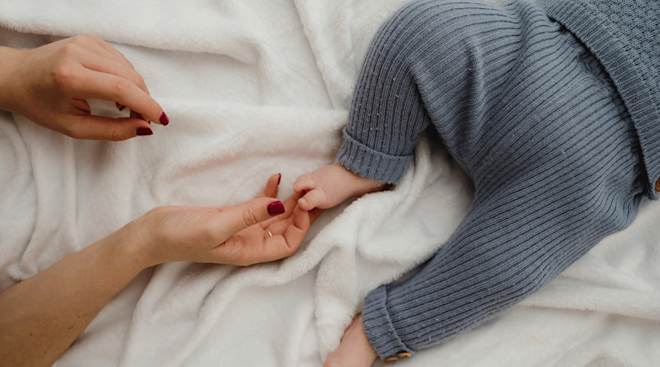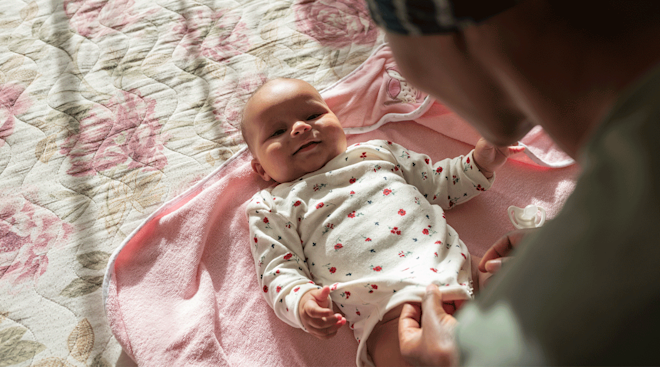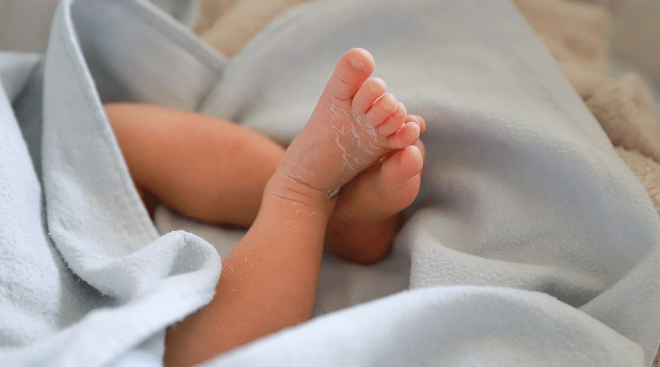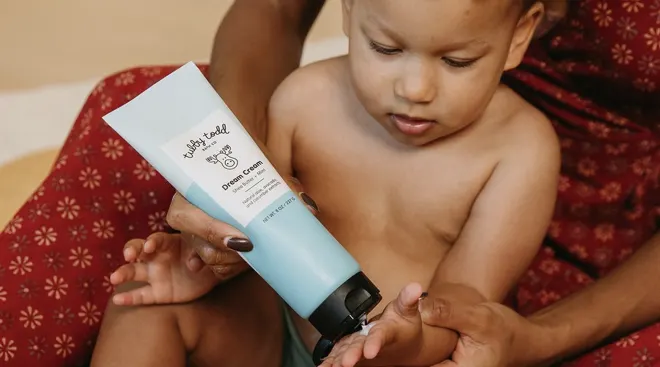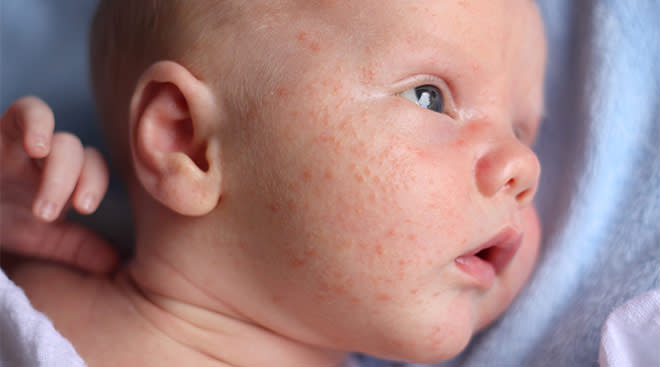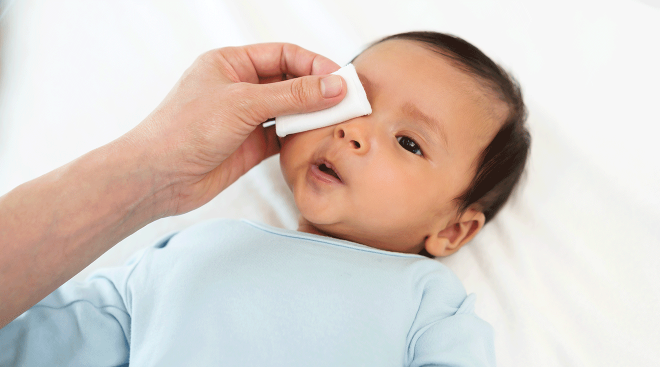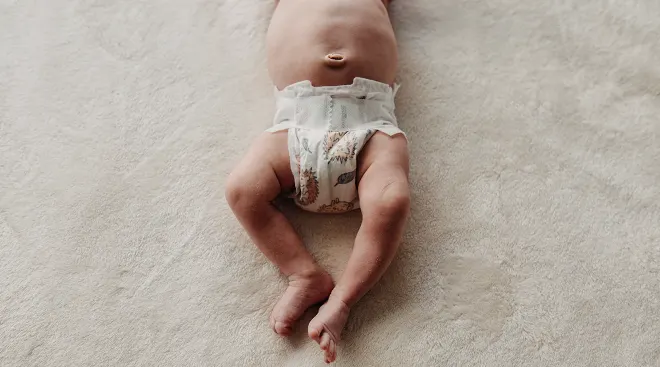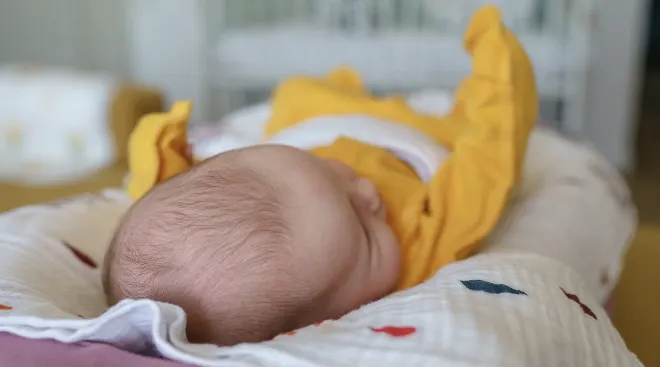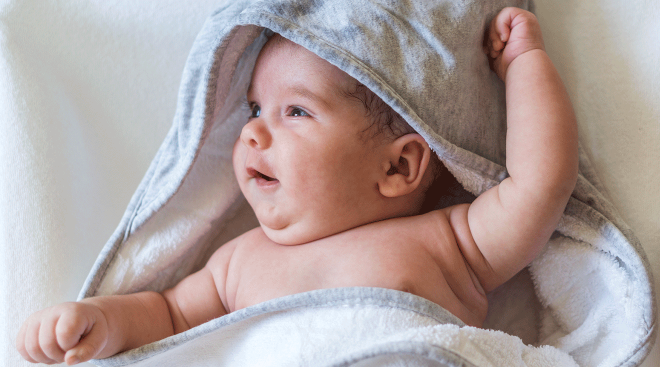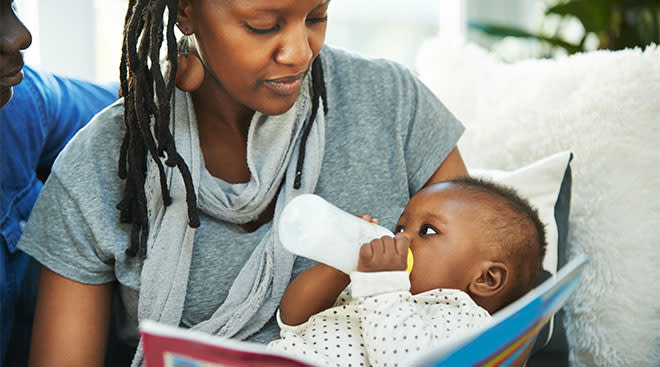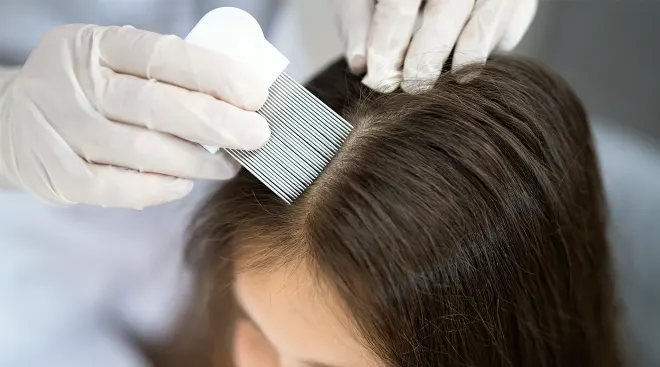What Causes Baby Eczema—and How to Treat It
Is there anything yummier than a baby’s soft, smooth skin? Though babies are known for exactly that, picture-perfect skin isn’t always the case, and baby eczema is often to blame.
Babies have extra-sensitive skin, so they’re more prone to rashes than older kids or adults. So the next time you spot some suspicious dry patches on your little one’s body, don’t be alarmed—there’s a good chance it might be baby eczema. But what causes it? Moreover, what does baby eczema look like? We’re sharing all the ins and outs of this common condition, plus some baby eczema treatments that will soon get baby comfortable in their own skin again. Read on to learn what baby eczema is, how to spot it and how to treat it.
Baby eczema (or atopic dermatitis) appears as red or dry patches of skin, and it’s usually also itchy and rough. For babies who are predisposed to eczema, the first rashes typically appear around 2 to 4 months of age. “Baby eczema often starts as a pink, flaky rash on the cheeks and chin in young babies,” says Anna Bender, MD, a pediatric dermatologist at Weill Cornell Medicine and New York-Presbyterian in New York City. “Older babies who are of crawling age may develop the rash more on the outside of their arms and legs with dry, itchy, irritated skin patches. It may also feel rough to the touch like sandpaper.”
What are the different types of baby eczema?
While the National Eczema Association defines seven different types of the skin condition, baby eczema typically falls into one of four categories: atopic dermatitis, contact dermatitis, seborrheic dermatitis or dyshidrotic eczema.
- Atopic dermatitis: The most common type of eczema, atopic dermatitis is a chronic rash that’s usually hereditary, meaning there’s a family history of this condition or other allergies.
- Contact dermatitis: This type of rash is triggered by an outside element. Usually, the condition will go away once baby is no longer exposed to the offending ingredient or allergen. Chemicals, fragrances and soaps are a few examples of substances that can cause this type of rash. Even those detergents labeled specifically for babies may be the culprit.
- Seborrheic dermatitis: More widely known as cradle cap, this type of baby eczema is characterized by scaly skin patches on the scalp. It may be caused by genetics, hormones, oil buildup, yeast or a combination of these factors. Unlike most other forms of eczema, it’s not triggered by an allergy.
- Dyshidrotic eczema: This type of eczema appears on the hands and feet. It’s often caused by exposure to certain metals but can also be brought on by sweat and stress. While it can occur in babies and children, it’s more common in adults.
Is eczema common in babies?
The short answer is yes. Up to 20 percent of children in the United States may have some form of eczema, says Bender. According to the National Eczema Association, atopic dermatitis in particular affects 13 percent of children 18 and younger.
It can be unnerving when you see raw and irritated skin patches on your infant, so being able to identify eczema can reduce your anxiety and get baby treatment faster. So what does baby eczema look like? It’s easy to confuse baby eczema vs. acne since both can appear on the cheeks. But baby acne typically appears earlier in life than eczema. “Baby acne can start soon after birth, while eczema may show the first signs around 2 to 5 months of age,” says Latanya Benjamin, MD, a Florida-based pediatric dermatologist and dermatologic surgeon and Society for Pediatric Dermatology board member. “Additionally, baby acne appears as classic pimples and small red pustules on the face usually with no symptoms. Eczema, on the other hand, affects both the face and body with dry or weepy red patches and is quite itchy.”
While eczema in babies with lighter skin typically looks pink, it may have a purple or gray tone in children with darker skin.
Another clue your little one may have this skin condition? Babies with eczema tend to rub their face with their hands or on their parents’ clothes, or rub their legs and feet or hands together.
Eczema in babies can be divided into three categories:
- Mild baby eczema: Minor cases usually appear as light pink, dry, itchy skin patches, Benjamin says, and can be treated with moisturizers alone.
- Moderate baby eczema: More noticable cases feature hot spots that are redder. Plus, moderate eczema can affect more of the body surface, Benjamin says; baby may need a cortisone cream or ointment (see below for baby eczema treatments).
- Severe baby eczema: This is the reddest and flakiest of all three varieties; it’s characterized by red, rough, thickened patches that are extremely itchy and often are crusty or have deep, scabbed cuts or cracks. Severe baby eczema is usually harder to control with over-the-counter products.
Baby eczema is thought to be caused by a combination of (or, more specifically, an interplay of) genetic and environmental factors. “It occurs in families with a history of eczema, asthma and seasonal allergies,” explains Bender. “The immune system of people with eczema is more allergically prone.” What’s more, she says, the skin lacks a strong barrier to the outside world, so it can become easily irritated and dry. As a result, these babies are especially sensitive to certain factors that will incite a breakout. Different babies may be particularly vulnerable to different agents. A few common triggers of eczema in babies include:
- Dry skin (which is why eczema can be common in winter)
- Irritants (such as soaps, household detergents, wool, polyester)
- Heat and sweating
- Infection
- Allergens (pet dander, pollen, dust)
- Saliva (from drooling)
Mild baby eczema may need nothing more than an over-the-counter moisturizer, but more severe cases may require treatment from your pediatrician. “The severity of the eczema dictates what the best treatment should be,” Benjamin says. “But every form of eczema demands proper skin care, including effective moisturization and itch control.” Whatever the case may be, always check in with your pediatrician if baby breaks out. Depending on the severity, your doctor may suggest some or all of these baby eczema treatment options:
- Creams: A gentle moisturizer is your first line of defense for baby eczema. “My son has eczema on his face and legs,” says one mom. “I use Aquaphor ointment on the patches for the flare-ups. Once that clears, we use regular Eucerin lotion after every bath, and his flare-ups have been really minimal.” Apply it all over baby’s body to soothe rough spots and also to improve the skin barrier function.
- Short baths with gentle cleansers: Proper daily skin care is crucial for keeping baby’s eczema-prone skin hydrated. Limit bathtime to 10 minutes and use warm—not hot—water. Choose gentle cleansers without fragrance, and avoid harsh soaps. After the bath, pat—don’t rub—baby’s skin dry within three minutes of taking them out of the water. Finally, apply moisturizer to their whole body.
- Prescription creams and ointments: If the problem doesn’t go away, your pediatrician may suggest a prescription for a low- to medium-strength topical steroid ointment or cream, which can be used once to twice daily to help the inflammation and heal the skin. If you’re prescribed creams or ointments, it’s important to follow up with a doctor as directed to make sure it’s working properly. One mom we spoke to was given a cream that she applied four times a day on her daughter, who had dry, bumpy skin all over her arms, legs, belly and back. “It went away. Then it came back about three weeks after I stopped using the cream, but not nearly as bad as the first time,” she says. “I applied the cream a few more times, and it hasn’t been back since. It’s been about three weeks now.”
- Diluted bleach baths: Inflamed skin is also more prone to infection. According to Benjamin, diluted bleach baths can not only safely manage infected eczema, but also help minimize the use of multiple courses of oral antibiotics for kids with repeated bacterial skin infections. She suggests adding ¼ to ½ cup of regular household bleach to a full-size bathtub with 1 inch of water. Talk to your pediatrician before trying a diluted bleach bath for baby eczema.
Baby eczema natural remedies
Since babies have extra-sensitive skin, it’s natural to want to treat it, well, naturally. But, Bender says, “even natural products have the potential to cause a worsened rash called contact dermatitis, so check with your doctor first before applying something new to baby’s skin.” Furthermore, Bender advises testing a new product before first-time use, and opting for “gentle products with simple ingredient lists.” (And always keep an eye out for any allergic reactions!) Here are a couple natural baby eczema remedies that are safe for baby:
- Coconut oil is a natural moisturizer.
- Medical grade honey can help shallow cuts and prevent a local skin infection, Benjamin suggests. (Just make sure babies younger than 12 months don’t ingest any.)
- A home remedy for baby eczema is “wet wrap therapy” (also called wet pajama therapy). Bathe your child, and then apply a thick moisturizer to the slightly damp skin. Dampen a pair of cotton pajamas in warm water, wring them out and slip them on baby, right over the thick layer of moisturizer. After that, put on a second dry pair of cotton pajamas. Keep baby wrapped like this for a few hours or longer.
Good news for nursing moms: There may be a correlation between breastfeeding and lower incidence of baby eczema. A study found that babies who were exclusively breastfed for the first three months of life were less likely to develop eczema through age 6. While breastfeeding may not completely prevent these rashes, it could potentially reduce some flareups.
If this is the first time baby is experiencing red or irritated skin, it’s best to contact your doctor to confirm whether it’s baby eczema or another condition. Once you get a diagnosis, you can start taking the appropriate steps and trying some baby eczema treatments.
But if the skin irritation is accompanied by a fever, or the bumps and patches start to ooze, scab, blister or look honey-crusted, it may be a sign of infection, and you’ll want to consult your child’s doctor right away.
According to the American Academy of Pediatrics, while some babies may continue to experience eczema through adulthood, many will outgrow it around age 4.
Baby eczema may also evolve as your little one gets older. According to the National Eczema Association, it might appear on baby’s face in early infanthood but pop up in key areas like the knees, elbows and hands as they get older. As they approach big-kid territory, eczema often hides in knee folds or elbow creases and other sweat-prone spots.
Whether eczema is an acute or perpetual problem for your child, it’s reassuring to know that there are many baby eczema treatments and preventive measures you can take to reduce the symptoms and alleviate the itch.
No one likes to see their baby in discomfort—and the appearance of any rash can be disconcerting. But if you recognize eczema, you can rest assured that it’s common and treatable.
Please note: The Bump and the materials and information it contains are not intended to, and do not constitute, medical or other health advice or diagnosis and should not be used as such. You should always consult with a qualified physician or health professional about your specific circumstances.
Plus, more from The Bump:
Anna Bender, MD, is a pediatric dermatologist at Weill Cornell Medicine and New York-Presbyterian in New York City. She received her medical degree at the Columbia University College of Physicians and Surgeons.
Latanya Benjamin, MD, FAAD, FAAP, is a Florida-based pediatric dermatologist and dermatologic surgeon and Society for Pediatric Dermatology board member. She earned her medical degree at Drexel University College of Medicine in Philadelphia, Pennsylvania.
National Eczema Association, 7 Types of Eczema, 2023
National Eczema Association, Causes, symptoms, treatment and more, 2023
Journal of Allergy and Clinical Immunology, Exclusive breastfeeding in infancy and eczema diagnosis at 6 years of age, February 2019
American Academy of Pediatrics, Eczema in Babies and Children, March 2021
Learn how we ensure the accuracy of our content through our editorial and medical review process.
Navigate forward to interact with the calendar and select a date. Press the question mark key to get the keyboard shortcuts for changing dates.
































